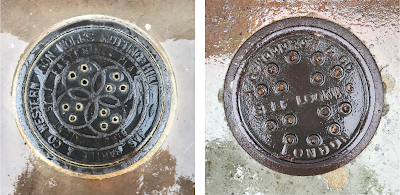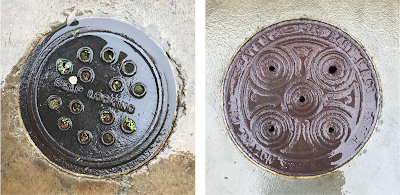Wandering westwards along Roman Road recently from its welcoming arch at the Parnell Road seeing how the road has evolved from the wonderfully scuzzy and diverse market street I used to know in the 1970s when my friend's family lived nearby, I arrived at the junction of Grove Road and pondered whether to carry on to Bethnal Green, head south to Mile End, or go for wander along the canal to Hackney. There's lots to see here. Instead, I entered the green space opposite the St Barnabas church and revisited a patch of art history.
Scrutinising the ground, I found what I was looking for. A couple terracotta bricks in an L shape were partially obscured by the grass so I scraped away at the area with the soles of my shoes to better reveal them, then repeated the process at other spots close by.
These are some of the bricks that indicate the outline of where Rachel Whiteread's 'House' used to be, at what was No.193 Grove Rd. To see the original house and the artwork's construction see this film on YouTube. It was here in 1993, that this major artwork was demolished as Rachel won the Turner Prize that year.
For the life of me I still cannot fathom how that decision was made – the demolition, not the winner of the Turner Prize! It's akin to the destruction of the Art Deco Firestone Factory in West London. Had 'House' been on land that was earmarked for development and reconstruction then I might understand that its removal was necessary. But today there's just a large expanse of mown grass mostly used by dog walkers.
30 years ago Rachel's star was in ascendance, yet a bad decision was made to remove her innovative and thought-provoking sculpture. It always seems to me in these situations that no-one wants the 'responsibility' to be the one who authorises a controversial decision that might rock the boat. No-one wants to be the person who instigates a U-turn. The powers that be, the pen pushers, the jobsworths, the complainers, the people unable to see further than their noses, the people who just do what they are told, the contractors, the "it's out of my control, I've got a bit of paper" people who justify themselves by carrying out orders and not being personally responsible for these things. All exacerbated by non-thinking fools who just repeat whet they see in the tabloids about an 'ugly lump of concrete' yet rarely do readers visit the project themselves or attempt to understand the rationale, the meaning, the relevance to local and social history that is being told.
People who did notice me taking pics and pacing out the ground simply looked at me like I was a bit bonkers. Which I'll accept! Had they known what I was doing I am sure they'd have come over for a chat as I was being rather obvious about it. Ah Well. What's gone is gone. All that's left, three decades later, is a few bricks in the grass, but there's no explanation for them. I had expected to find something of that kind attached to one the benches that sit in the long grass within the plot, but no.
Something else I noticed that day, which I thought was bizarre, was the nearby two picnic benches:
These both had small cushions on them at the corners (not fixed in place) and one had a briefcase at one edge and a clip board at the other. It looked a bit religious, as if some people had just had a meeting and then wandered off, leaving their stuff behind. Is it always like this? Or was it just on that Saturday?
Then I noticed, between the adjacent bushes, some remnants of cushions and other food-related rubbish, plus a discarded Tigger stuffed toy. Looks like a dog had attacked a family picnic!
What's that all about?!











